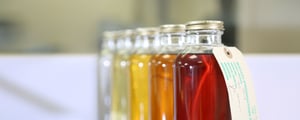
Labor-Dienstleistungen
EOS bietet sämtliche Isolieröl-Dienstleistungen und -Produkte aus einer Hand an. Dazu gehören auch Isolieröltests, die wir in unserem eigenen Labor durchführen.
Die Zuverlässigkeit und Leistungsfähigkeit von Energieversorgungsanlagen hängt maßgeblich von der Verfügbarkeit der Transformatoren ab. Diese sorgen dafür, dass der erzeugte Strom mit der erforderlichen Spannung in das Stromnetz eingespeist wird.
Die Verfügbarkeit von Öl-gefüllten Transformatoren wird wesentlich von einer gleichbleibend hohen Isolierölqualität bestimmt. Über die Zeit und im laufenden Betrieb verschlechtert sich jedoch die Isolierölqualität. Die anfangs vorhandenen Inhibitoren – bedeutend für die so genannte Oxidationsstabilität - werden aufgebraucht und der Säuregehalt im Isolieröl steigt.
Die Isolierölqualität kann durch Entnahme einer Ölprobe und deren Prüfung nach internationalen Standards bestimmt werden. EOS unterhält dazu eigene Laboreinrichtungen in Großbritannien und Deutschland.
Unsere Labor-Dienstleistungen auf einen Blick:
- Ölprobenahme bei Ihnen vor Ort
- Ölprobenanalyse im eigenen EOS Labor
- Zustandsbeurteilung und Handlungsempfehlung
Einfache Ölanalyse bestätigt die Qualität
Lassen Sie Ihrem Transformator regelmäßig – beispielsweise bei einem gesetzlich vorgeschriebenen Audit – eine Isolierölprobe entnehmen und diese nach den Standardwerten (VDE-Test) analysieren. So erhalten Sie erste Hinweise über den Zustand des Isolieröls.
Für kritische Transformatoren bieten wir Ihnen weitere Analysen an: Überwachung der Grenzflächenspannung IFT, des dielektrischen Verlustfaktors DDF (Tan Delta) und des Zustands der Papierisolierung (DP). Die Ergebnisse dieser Analysen liefern Ihnen zusätzliche forensische Informationen, die als Grundlage für Ihre Entscheidungen dienen können.
Wie Blutproben bringen detaillierte Analysen von Transformatorenöl-Stichproben vieles über die Qualität und den Zustand des Öls sowie des Transformatorensystems ans Licht. Den guten Zustand von Öl und somit von Transformatoren können Sie erhalten, indem Sie ein paar einfache Regeln befolgen:
Kühl halten: Je Senkung der Betriebstemperatur um 6 °C verdoppelt sich die Lebensdauer eines Transformators. Sorgen Sie also für gute Belüftung, insbesondere bei eingehausten Transformatoren.
Regelmäßig prüfen: Der erste und wichtigste Schritt für Prüfungen und Analysen des Isolieröls ist, eine „repräsentative“ Probe des Öls zu nehmen. Anleitungen finden Sie hier.
Bedarfsgerecht testen: Abhängig vom Zustand Ihres Transformators und dem Ergebnis der Standardwerte unterstützen Sie EOS bei der Wahl weiterer Tests.
Frühzeitig handeln: Ist Ihr Transformator für den Betrieb Ihrer Anlage elementar, empfiehlt es sich, das Öl zeitig zu regenerieren, sodass es wieder einen Zustand „wie neu“ erreicht. Dies verhindert eine weitere Schädigung der Papierisolierung.
Gerne helfen wir Ihnen zum Beispiel bei der Entnahme aussagekräftiger Stichproben und bei der Auswertung der Ergebnisse. Sprechen Sie uns an!
Öltests erinnern an Blutproben: Eine vernünftige Stichprobe verrät sehr viel über den Transformator – vom allgemeinen Zustand des Isolieröls bis zum Ausfallrisiko des Transformators.
Eine systematische Stichproben- und Prüfroutine kann zu einem strategisch besseren Transformatoren-Management führen. Werden die Öltests auf die jeweiligen Transformatoren zugeschnitten, unterstützt das die Verwaltung und macht sie kostengünstiger.
Das EOS-Fachpersonal weist eine über 60-jährige Erfahrung vor und kann Ihnen Tipps geben, etwa zu Stichprobentechniken oder zur Auswahl von Testverfahren. Dies ist Teil des Rundum-Angebots von EOS.
Dank unseres eigenen EOS-Labors umfasst unser Angebot mehr als nur Ölanalysen. Zum Portfolio zählen Standard-Öltests ebenso wie die ausgefeilte Analyse zur Bestimmung des Zustands der Papierisolierung. Trendanalysen von gelösten Gasen können ebenfalls dazu beitragen, Transformatorenausfälle zu antizipieren.
Im Alltag hängt es von einer Vielzahl technischer und wirtschaftlicher Faktoren ab, welche Tests erforderlich sind. Erörtern Sie dies mit unseren Spezialisten, die gemeinsam mit Ihnen die geeignetste Methode festlegen.
Für weitere Informationen stehen wir Ihnen gerne zur Verfügung. Wir beraten Sie vorab und unterstützen Sie bei Ihren Prüfverfahren. Sprechen Sie uns bitte jederzeit an.
Why should I use a glass sampling thief?
There are three reasons for favouring glass for sampling thieves.
-
It is resistant to scratching, which can harbour contamination.
-
It is relatively easy to keep clean.
-
It is quite evident when it is not clean.
How should I take a sample of oil from a Drum?
The purpose of sampling is to produce an accurate representation of the body of the oil, ensuring any contaminants present are found, while excluding those from external sources. It should be remembered that all contact with air, sampling equipment etc. could have an influence on the sample. Ideally, all external influences, such as airborne contamination, rain, dust etc. should be totally excluded. In some cases, where sampling under poor conditions is necessary, this may mean the erection of a small tent or makeshift cover. A 500ml sample will be sufficient to carry out all routine, PCB and DGA tests.
Allow the oil in the drum to acclimatise by achieving equilibrium with the ambient temperature. Clean the area around the bung. Remove the tab-seal and the bung using a drum key. Inspect the bung seal for signs of damage or contamination. Remove your glass sampling thief from its protective case and inspect and wipe the outside of it. Insert the thief into the oil about half way, place a finger or thumb over the top end and withdraw. The thief is now half full of oil. This is used to rinse the inside of the thief by rocking it in a “see-saw” motion while rolling it to ensure total rinsing of the internal surface. This should be done over a large drip-tray. Repeat and examine. Using the same technique as above, withdraw half a thief of oil and place it in the sample bottle. Rest the thief in the oil drum where it will be safe and clean. The sample bottle is then capped and rinsed by vigorously shaking it. Continue shaking while discarding oil to prevent any contaminants adhering to the side of the bottle. Repeat and examine.
To take a sample from the bottom of the drum, which is where any contaminants, if present, are most likely to be found, insert the thief into the drum ensuring that the finger or thumb covering the top hole is not removed until the thief reaches the bottom of the drum. Then uncover the hole allowing oil from the bottom of the drum to enter the thief. While this is happening, the thief should be moved across the bottom of the drum and around the bottom seam. When the oil level in the thief is the same as that in the drum, uncap the sample bottle and cover the top hole of the thief and withdraw it from the drum lifting it vertically. Hold the bottle over a bucket or drip tray, and, without placing the end of the thief in the top of the bottle, uncover the top hole and aim the oil into the sample bottle such that it flows down it’s side. Repeat until the bottle is full and overflowing. The overflowing will help to release any air bubbles from the bottle. Pour the surplus oil from the bottle over the cap to rinse. Leave a 0.5-1cm air gap and finger tighten the cap. Be careful not to over-tighten. Replace bung to drum. Gently invert the sample bottle and inspect for visible solid contamination and/or free water. If contamination is found, the sample should be discarded and the above procedure repeated to ensure that the first was representative. Complete the sample data sheet or label in full.
How should I take a sample of oil from a Switch Tank?
Although it is normal practice to remove oil from switch gear for maintenance and replace with oil of a known and certified quality standard, samples, either “as found” or “as left” are often taken for diagnostic or statistical purposes.
The purpose of sampling is to produce an accurate representation of the body of the oil, ensuring any contaminants present are found, while excluding those from external sources. It should be remembered that all contact with air, sampling equipment etc. could have an influence on the sample. Ideally, all external influences, such as airborne contamination, rain, dust etc. should be totally excluded. In some cases, where sampling under poor conditions is necessary, this may mean the erection of a small tent or makeshift cover. A 500ml sample will be sufficient to carry out all routine, PCB and DGA tests.
Clean the switch lid, paying particular attention to the external rim of the gasket seat, a favourite home of insects. Remove the switch lid and carry out a visual inspection. Using a torch if necessary, check as much of the base of the tank as possible, especially in corners and directly beneath any access covers, sight glasses or operating mechanism bushes. Record the nature and location of any contamination found. Remove your glass sampling thief from its protective case and inspect and wipe the outside of it. Insert the thief into the oil short of the tank bottom, place a finger or thumb over the top end and withdraw. The thief is now about half full of oil.
This is used to rinse the inside of the thief by rocking it in a “see-saw” motion while rolling it to ensure total rinsing of the internal surface. This should be done over a large drip-tray. Repeat and examine. Using the same technique as above, withdraw half a thief of oil and place it in the sample bottle. Rest the thief in the switch tank where it will be safe and clean. The sample bottle is then capped and rinsed by vigorously shaking it. Continue shaking while discarding oil to prevent any contaminants adhering to the side of the bottle. Repeat and examine.
To take a sample from the bottom of the switch, which is where any contaminants, if present, are most likely to be found, insert the thief into the switch ensuring that the finger or thumb covering the top hole is not removed until the thief reaches the bottom of the tank. Uncover the hole allowing oil from the bottom to enter the thief.
While this is happening, the thief should carefully be moved across the bottom of the tank as much as possible. When the oil level in the thief is the same as that in the switch, uncap the sample bottle and cover the top hole of the thief and withdraw it from the switch lifting it vertically. Hold the bottle over a bucket or drip tray, and, without placing the end of the thief in the top of the bottle, uncover the top hole and aim the oil into the sample bottle such that it flows down it’s side. Repeat, taking successive dips from different parts of the switch, until the bottle is full and overflowing. The overflowing will help to release any air bubbles from the bottle.
Pour the surplus oil from the bottle over the cap to rinse. Leave a 0.5-1cm air gap and finger tighten the cap. Be careful not to over-tighten. Gently invert the sample bottle and inspect for visible solid contamination and/or free water. If contamination is found, the sample should be discarded and the above procedure repeated to ensure that the first was representative. Complete the sample data sheet or label in full.
How should I take a sample of oil from a transformer?
The purpose of sampling is to produce an accurate representation of the body of the oil, ensuring any contaminants present are found, while excluding those from external sources. It should be remembered that all contact with air, sampling equipment etc. could have an influence on the sample. Ideally, all external influences, such as airborne contamination, rain, dust etc. should be totally excluded. In some cases, where sampling under poor conditions is necessary, this may mean the erection of a small tent or makeshift cover. A 500ml sample will be sufficient to carry out all routine, PCB and DGA tests.
If there is not a dedicated sample point provided, fit a sampling adapter to a drain valve or filter valve. Ensure that the exterior of the valve and adapter is clean before fitting. Open the valve and establish a controllable & directional flow into a bucket. Use a plastic hose kept especially for the purpose. Clean the interior of the valve, sample adapter and hose by flushing with oil, allow 2-3 litres to flow to ‘waste’ – do not adjust the flow rate from now on. Record the oil temperature as the flushing oil runs into the bucket. Do not put the thermometer into the sample bottle. Rinse the sample bottle 2 or 3 times by half filling it and vigorously shaking it.
Continue shaking while discarding oil to prevent any contaminants adhering to the side of the bottle. Repeat and inspect for cleanliness. Fill the bottle gently by directing the flow down the side to reduce aeration until the bottle is full and overflowing.
The overflowing will help to release any air bubbles from the bottle. Run some oil over the cap to rinse it. Leave a 0.5-1cm air gap and finger tighten the cap. Be careful not to over-tighten. Close the sample valve. Gently invert the sample bottle and inspect for visible solid contamination and/or free water. If contamination is found, the sample should be discarded and the above procedure repeated to ensure that the first was representative. Complete the sample data sheet or label in full.
My transformers are only small but they feed critical services, what oil tests can I do to monitor their condition?
In many instances, the value of an item of oil-filled plant will not be related to its capital cost, but to the importance of the load it supplies. Hence even relatively small, low rating and low cost plant can justify the performance of sophisticated monitoring techniques such as dissolved gas analysis (DGA).

Mit den Experten
sprechen
sprechen
Fallstudien
Specialised oil testing
The customer was a major steel manufacturer in the North East of England, who made initial contact with EOS as…
Kontaktieren Sie uns!
Electrical Oil Services GmbH
Oehleckerring 6a
22419 Hamburg
Tel.:+49 40 500 910 850
Electrical Oil Services GmbH – Werk Duisburg
Krabbenkamp 11
47138 Duisburg
Tel.: +49 203 45 65 482
Dank unserer umfassenden Erfahrung mit Aufbereitung, Lagerung und Bereitstellung von Isolierölen (auch vor Ort) wissen unsere Kunden sich bei uns in Sachen Servicequalität und Standards stets auf der sicheren Seite.
Bei uns erhalten Sie sowohl ungebrauchtes als auch rückgewonnenes Isolieröl sowie eine ganze Reihe ergänzender Produkte.
Unsere Mitarbeiter sind mit Leidenschaft dabei, wenn sie in ihrem Fachgebiet ehrlich, offen und sachkundig beraten.


